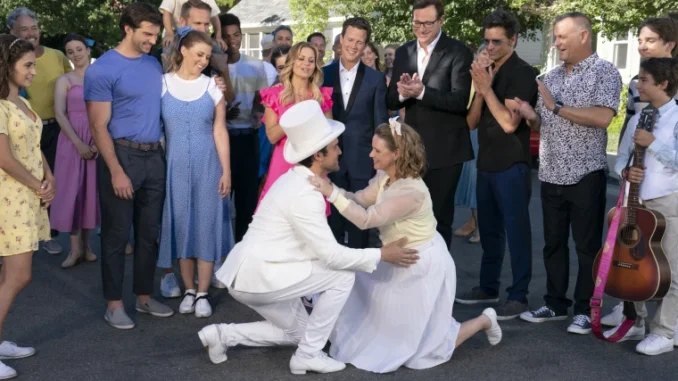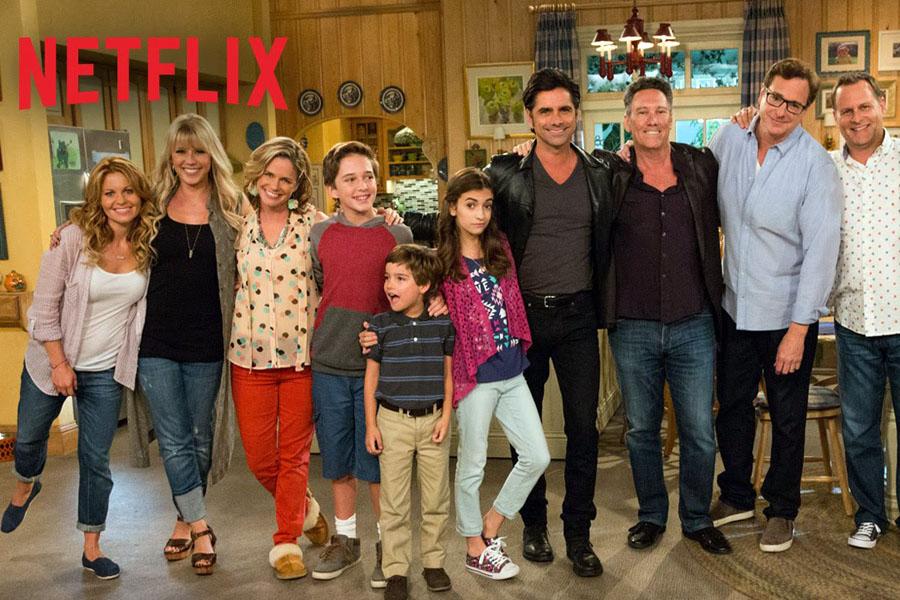
One of the best-known sitcoms of the 1990s, “Full House” went off the air in 1995; it would be another 20 years before Netflix decided to pick up the spinoff “Fuller House,” in 2016. “Fuller House” was part of an experiment by the streaming service to see if the old-school, laugh-track sitcom could be reimagined for a new generation. (“One Day at a Time,” the reimagined version of the Norman Lear show, arrived less than a year later.)
:max_bytes(150000):strip_icc():focal(511x0:513x2)/fuller-house-1024-4-9a8353a497234cfe9abd41143cd5149c.jpg)
“Fuller House’s” conceit fit right into the landscape of gender and race-flipped reboots. Original child star Candace Cameron Bure, who played oldest daughter D.J. in the original series, is now a widow raising three sons. Her two single gals — original sister Stephanie (Jodie Sweetin) and childhood BFF Kimmy Gibbler (Andrea Barber) — move in to help out. But after five successful seasons, the series is now drawing to a close, having proven that there is an audience for undemanding entertainment that works hard to never surprise you, despite broadcast mostly leaving such shows by the wayside.

When “Full House” debuted back in 1987, it was already feeling nostalgic. The opening lyrics pointedly hark back to the time of “All In the Family” (although that show’s most successful spinoff, “The Jeffersons,” had only gone off the air all of a year before). “Whatever happened to predictability,” sang Jesse Frederick in the theme song, as he pines for “the milkman, the paperboy, evening TV
The show’s plot was a knockoff of “Three Men and a Baby,” (which also arrived that year), with widowed father Danny Tanner (Bob Saget) and brother-in-law Jesse Katsopolis (John Stamos) and friend Joey Gladstone (Dave Coulier) banding together to raise Tanner’s three daughters, D.J. (Bure), Stephanie (Sweetin), and Michelle (played by twins Mary-Kate and Ashley Olson). The show was never a hit with critics, but it became a phenomenon as the Olson twins grew up on camera, later parlaying what started as a minor role into an empire.

Ironically, although the show’s popularity hinged on the Olsons, they’ve become too big for spinoffs. But Bure, Sweetin, and Barber (also from the original cast) have had far less success outside their child star roots. Bure is better known for her evangelical Christian beliefs than her work in endless Hallmark Channel films, and Sweetin for her struggles with substance abuse after “Full House” ended than any roles she’s done. Barber retired from acting after the series ended and has only returned to TV to reprise the Gibbler role. But the real driving force to bring “Full House” back actually seems to have been Stamos, who at some point acquired an ownership stake in the series, and, according to “Entertainment Weekly,” was “instrumental” in selling the spinoff.
.”

Given the sentimentality of “Full House,” a reboot makes sense as a nostalgia play. A theme song begging for a return to “predictability” has only become more poignant as President Donald Trump’s administration continues. But the show also took a real risk by bringing back the old-fashioned sitcom format. There’s a deliberate woodenness to the delivery, a slowness to the dialogue necessitated by waiting for the audience to obediently laugh at every punchline. “Fuller House” insists this kind of show still has a place in the TV landscape and that audiences still long for broad comedy done adequately.
Critics were unimpressed, to say the least. Where revivals like “One Day at a Time,” now cast with a Cuban American family, were praised for giving audiences the familiar with a twist, “Fuller House” was not interested in twists. In fact, it created the most conventional series imaginable. At least the original upended the idea that men can’t raise daughters, airing as it did at the height of the anti-feminist backlash to the 1970s push for ERA. There is literally nothing unconventional about “Fuller House,” right down to the overarching goal of its five-season run, which is for all three main women to get married.

But despite all that, “Fuller House” has been a ratings hit for Netflix, at least according to third party measurements. (Netflix has never released numbers for the show.) This despite the bad PR generated by longtime star Lori Laughlin, the series’ “Aunt Becky,” who simply disappears (apparently to Nebraska) in this final run of episodes due to Laughin’s criminal involvement with the Varsity Blues scandal. “Fuller House” is very much a testament to the belief that as long as it doesn’t happen on screen, audiences won’t notice. And other than a snide tweet or two about the sudden disappearance of Aunt Becky, chances are, no one will miss her.
As “Fuller House” rides off into the sunset, or a promised finale full of weddings, critics will most likely say good riddance. But the series has done what it set out to do, proving to networks that shows like this can and do still work.
